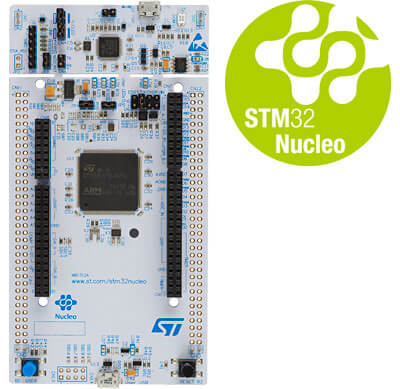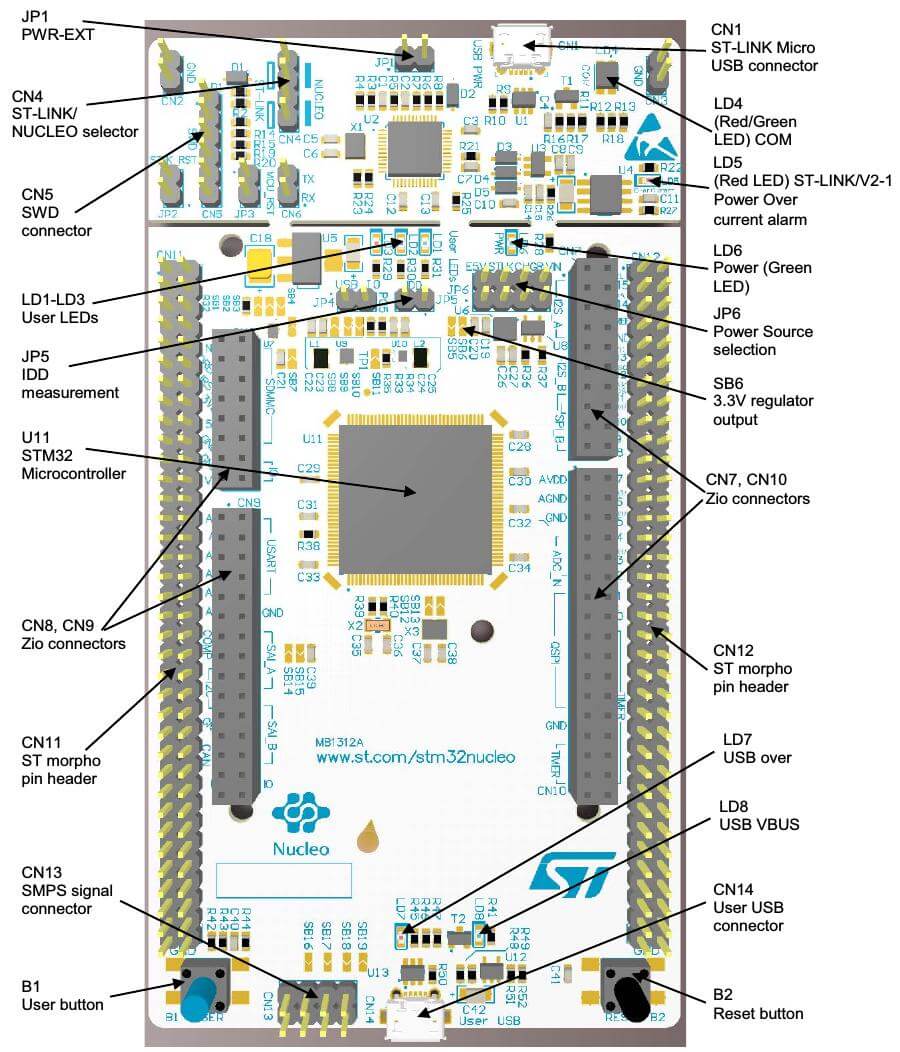ST Nucleo L4R5ZI¶
Overview¶
The Nucleo L4R5ZI board features an ARM Cortex-M4 based STM32L4R5ZI MCU with a wide range of connectivity support and configurations. Here are some highlights of the Nucleo L4R5ZI board:
STM32 microcontroller in LQFP144 package
Two types of extension resources:
Arduino Uno V3 connectivity
ST morpho extension pin headers for full access to all STM32 I/Os
On-board ST-LINK/V2-1 debugger/programmer with SWD connector
Flexible board power supply:
USB VBUS or external source(3.3V, 5V, 7 - 12V)
Power management access point
Three User LEDs: LD1 (Green), LD2 (Blue), LD3 (Red)
Two push-buttons: USER and RESET

More information about the board can be found at the Nucleo L4R5ZI website.
Hardware¶
The STM32L4R5ZI SoC provides the following hardware IPs:
Ultra-low-power with FlexPowerControl (down to 130 nA Standby mode and 100 uA/MHz run mode)
Core: ARM® 32-bit Cortex®-M4 CPU with FPU, adaptive real-time accelerator (ART Accelerator) allowing 0-wait-state execution from Flash memory, frequency up to 120 MHz, MPU, 150 DMIPS/1.25 DMIPS/MHz (Dhrystone 2.1), and DSP instructions
Clock Sources:
4 to 48 MHz crystal oscillator
32 kHz crystal oscillator for RTC (LSE)
Internal 16 MHz factory-trimmed RC ( ±1%)
Internal low-power 32 kHz RC ( ±5%)
Internal multispeed 100 kHz to 48 MHz oscillator, auto-trimmed by LSE (better than ±0.25 % accuracy)
Internal 48 MHz with clock recovery
3 PLLs for system clock, USB, audio, ADC
RTC with HW calendar, alarms and calibration
Up to 24 capacitive sensing channels: support touchkey, linear and rotary touch sensors
Advanced graphics features
Chrom-ART Accelerator™ (DMA2D) for enhanced graphic content creation
Chrom-GRC™ (GFXMMU) allowing up to 20% of graphic resources optimization
MIPI® DSI Host controller with two DSI lanes running at up to 500 Mbits/s each
LCD-TFT controller
16x timers
2 x 16-bit advanced motor-control
2 x 32-bit and 5 x 16-bit general purpose
2x 16-bit basic
2x low-power 16-bit timers (available in Stop mode)
2x watchdogs
SysTick timer
Up to 136 fast I/Os, most 5 V-tolerant, up to 14 I/Os with independent supply down to 1.08 V
Memories
2-Mbyte Flash, 2 banks read-while-write, proprietary code readout protection
640 Kbytes of SRAM including 64 Kbytes with hardware parity check
External memory interface for static memories supporting SRAM, PSRAM, NOR, NAND and FRAM memories
2 x OctoSPI memory interface
4x digital filters for sigma delta modulator
Rich analog peripherals (independent supply)
12-bit ADC 5 Msps, up to 16-bit with hardware oversampling, 200 μA/Msps
2x 12-bit DAC, low-power sample and hold
2x operational amplifiers with built-in PGA
2x ultra-low-power comparators
20x communication interfaces
USB OTG 2.0 full-speed, LPM and BCD
2x SAIs (serial audio interface)
4x I2C FM+(1 Mbit/s), SMBus/PMBus
6x USARTs (ISO 7816, LIN, IrDA, modem)
3x SPIs (5x SPIs with the dual OctoSPI)
CAN (2.0B Active) and SDMMC
14-channel DMA controller
True random number generator
CRC calculation unit, 96-bit unique ID
8- to 14-bit camera interface up to 32 MHz (black and white) or 10 MHz (color)
Development support: serial wire debug (SWD), JTAG, Embedded Trace Macrocell (ETM)
More information about STM32L4R5ZI can be found here:
Supported Features¶
The Zephyr nucleo_l4r5zi board configuration supports the following hardware features:
Interface |
Controller |
Driver/Component |
|---|---|---|
NVIC |
on-chip |
nested vector interrupt controller |
UART |
on-chip |
serial port-polling; serial port-interrupt |
PINMUX |
on-chip |
pinmux |
GPIO |
on-chip |
gpio |
I2C |
on-chip |
i2c |
PWM |
on-chip |
pwm |
SPI |
on-chip |
spi |
USB |
on-chip |
usb |
ADC |
on-chip |
adc |
Other hardware features are not yet supported on this Zephyr port.
The default configuration can be found in the defconfig file:
boards/arm/nucleo_l4r5zi/nucleo_l4r5zi_defconfig
Connections and IOs¶
Nucleo L4R5ZI Board has 8 GPIO controllers. These controllers are responsible for pin muxing, input/output, pull-up, etc.
Default Zephyr Peripheral Mapping:¶
UART_1_TX : PA9
UART_1_RX : PA10
UART_2_TX : PA2
UART_2_RX : PA3
UART_3_TX : PB10
UART_3_RX : PB11
I2C_1_SCL : PB6
I2C_1_SDA : PB7
SPI_1_NSS : PD14
SPI_1_SCK : PA5
SPI_1_MISO : PA6
SPI_1_MOSI : PA7
SPI_2_NSS : PB12
SPI_2_SCK : PB13
SPI_2_MISO : PB14
SPI_2_MOSI : PB15
SPI_3_NSS : PB12
SPI_3_SCK : PC10
SPI_3_MISO : PC11
SPI_3_MOSI : PC12
PWM_2_CH1 : PA0
USER_PB : PC13
LD1 : PC7
LD2 : PB7
LD3 : PB14
USB DM : PA11
USB DP : PA12
ADC1 : PC0
System Clock¶
Nucleo L4R5ZI System Clock could be driven by internal or external oscillator, as well as main PLL clock. By default, the System clock is driven by the PLL clock at 80MHz, driven by a 16MHz high speed internal oscillator. The clock can be boosted to 120MHz if boost mode is selected.
Serial Port¶
Nucleo L4R5ZI board has 5 U(S)ARTs. The Zephyr console output is assigned to UART2. Default settings are 115200 8N1.
Network interface¶
Ethernet over USB is configured as the default network interface (EEM)
Programming and Debugging¶
Connect the Nucleo L4R5ZI to your host computer using the USB port. Then build and flash an application. Here is an example for the Hello World application.
Run a serial host program to connect with your Nucleo board:
$ minicom -D /dev/ttyACM0
Then build and flash the application.
# From the root of the zephyr repository
west build -b nucleo_l4r5zi samples/hello_world
west flash
You should see the following message on the console:
Hello World! arm
